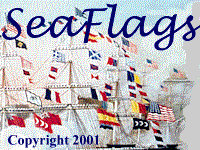
 |
Navy Award Pennants and Flags |
On this page:
Prizes for competitions among ships have long been a central element of U.S. Navy training programs, with the awarding of the battle efficiency "E" dating back to 1906. The first formal unit decoration for combat services, the Presidential Unit Citation, was introduced in 1942 to recognize extraordinary heroism in combat. It took the form of a burgee-shaped pennant to be displayed by the unit receiving it as well as a ribbon to be worn permanently on the uniform by those who were members at the time the service was performed. The same practice was subsequently followed for other unit commendations. Later, beginning in the 1970s, additional award flags were added to recognize achievements in other areas on which the Secretary of the Navy wished to place special emphasis--environmental protection, energy conservation, safety, and so on.
The Navy Awards Manual (SecNavInst 1650.1F)
provides for award pennants and flags awarded to ships to be flown from
the fore truck (or, in one-masted ships, the main truck) from sunrise to
sunset when not under way. Shore commands, or fleet units based ashore,
fly the pennant wherever the commanding officer considers appropriate,
normally from the starboard arm of a flagmast with a crosstree. Replicas
of unit citation pennants are also often painted on unit equipment. The
principal pennants and flags are flown in the following order of priority:
unit citations in the order of precedence shown below; Secretary of the
Navy award flags in order of establishment of the award; battle efficiency
pennant.
The
Secretary of the Navy Energy Conservation Awards, created in the wake of
the oil shortages of the 1970s, are presented annually to Navy and Marine
Corps installations, ships, aircraft squadrons, industrial facilities,
and other operational units pursuant to SecNavInst 4101.1 and
OpNavInst 4100.7B. Organizations winning the awards are entitled
to display the award flag for a period of one year from the date of the
announcement or until the next year's awards are announced.
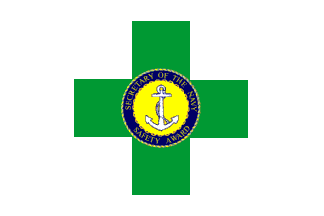 A Secretary of the Navy Safety Flag is authorized by SecNavInst 5100.15A
for display by shore installations in recognition of winning the Secretary
of the Navy Award for Achievement in Safety Ashore. The flag is white
with a green cross and the golden seal of the awards program on the
center.
A Secretary of the Navy Safety Flag is authorized by SecNavInst 5100.15A
for display by shore installations in recognition of winning the Secretary
of the Navy Award for Achievement in Safety Ashore. The flag is white
with a green cross and the golden seal of the awards program on the
center.
Ships
that win the annual type commanders' safety awards fly what is known as
the Green "S" Pennant from a yardarm while not under way (ComNavSurfLant/PacInst
3502.2E).
The pennant is so named because winners also paint a green
letter "S" on the port and starboard bridge bulwarks alongside the letters
for other efficiency competitions.
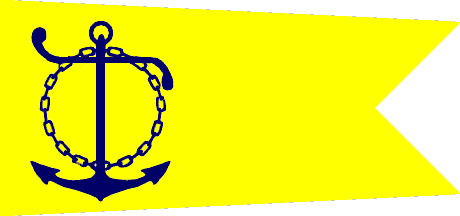 This
pennant recognizes ships, aircraft squadrons, shore commands
and other units and organizations for achieving high levels of personnel
retention--getting sailors to reenlist and stay in the Navy at the end
of their first, second, and later terms of enlistment. It is awarded
by the two fleet commanders in chief as well as by the commanders of other
major commands.
This
pennant recognizes ships, aircraft squadrons, shore commands
and other units and organizations for achieving high levels of personnel
retention--getting sailors to reenlist and stay in the Navy at the end
of their first, second, and later terms of enlistment. It is awarded
by the two fleet commanders in chief as well as by the commanders of other
major commands.
Return to top of page
The Commanders of Submarine Forces Atlantic Fleet and Submarine Forces Pacific Fleet award the flags shown below to vessels under their cognizance whose officers and enlisted personnel meet established standards for percentages qualifying for the officers' gold submariners' dolphins and the enlisted silver submariners' dolphins. These flags date back at least to the 1960s. They are flown while not under way from a staff attached to the after edge of the submarine's sail (conning tower).
In 1998, the naval surface forces of both the Atlantic and Pacific Fleets
jointly introduced two "pennants," actually rectangular flags, to recognize
achievements in qualifying crew members as surface warfare officers and
enlisted surface warfare specialists. Both pennants are blue with
the officers and enlisted surface warfare breast insignia on the center.
These flags are flown at the main when not under way, immediately above
battle
efficiency pennants. Since the merger of the Atlantic and Pacific surface forces into a single Naval
Surface Force, the award of these pennants is governed by COMNAVSURFOR Instruction 3502.1D.
To
receive the "gold pennant," all of a ship's officers who have been aboard for 18 months or longer and are eligible for
surface warfare qualification must be so qualified.
A ship may fly the "silver pennant" if all sailors
in the grades of E-5 through
E-9 who have been on board for 18 months or more are qualified as enlisted surface warfare specialists.
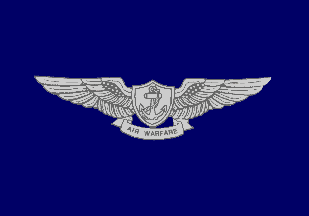 This pennant has recently been introduced for
aircraft carriers whose sailors meet a specified standard of qualification as enlisted air warfare specialists.
This pennant has recently been introduced for
aircraft carriers whose sailors meet a specified standard of qualification as enlisted air warfare specialists.
The
Commander in Chief's Award for Installation Excellence was established
by the President to reward outstanding overall management of military installations.
Each military service selects one winning installation each year. OpNavInst
1650.23C authorizes installations that win the award to display the
excellent installation flag for a period of one year from the date of receiving
the award. The hoist of the flag is blue with the Presidential coat of
arms in gold above numerals indicating the year for which the award is
presented. The fly of the flag is red with two white blocks, forming a
large letter "E" for excellence. This flag is flown along with other award
flags from the left arm of the crosstree of the winning installation's
flagmast.
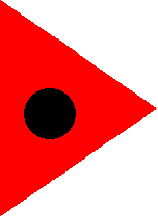 |
The battle efficiency pennant, or "meatball," (left) is flown at the truck of the foremast when not under way, beneath any citation pennants or Secretary of the Navy award flags, to signify a ship's winning of the annual fleetwide competition for sustained superior performance in an operational environment. In addition, the winning ship paints a large white "E" on the bridge bulwarks on both the port and starboard sides of the ship. A ship that wins five consecutive battle efficiency competitions replaces the white "E" with a gold one and is entitled to the special battle efficiency pennant (right). Besides the battle efficiency "E", ships also compete for a number of specialized awards signified by the painting of various letters and symbols on the ship. |
|
|
Pennant |
Efficiency Pennant |
Return to top of page
Return to Sea Flags home page
Sea
Flags
Copyright 2000, 2001 by Joseph McMillan